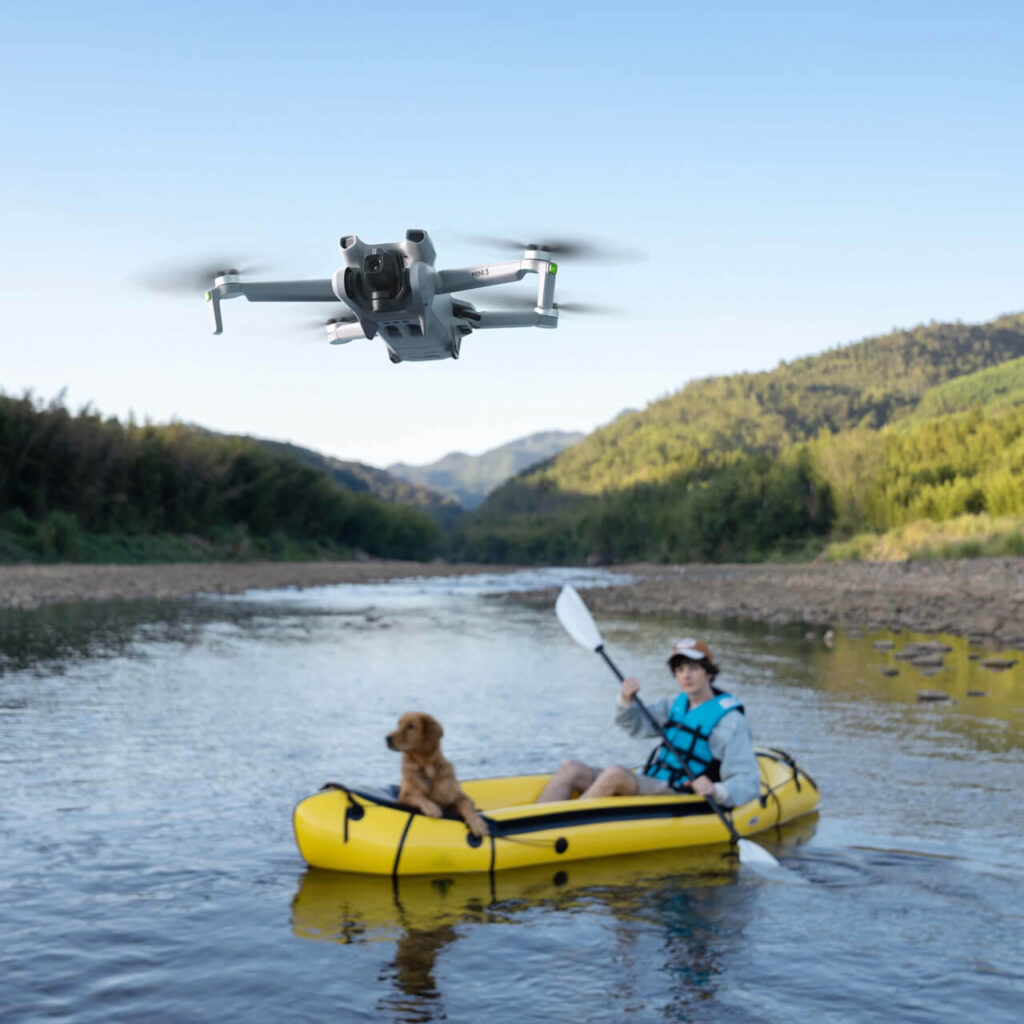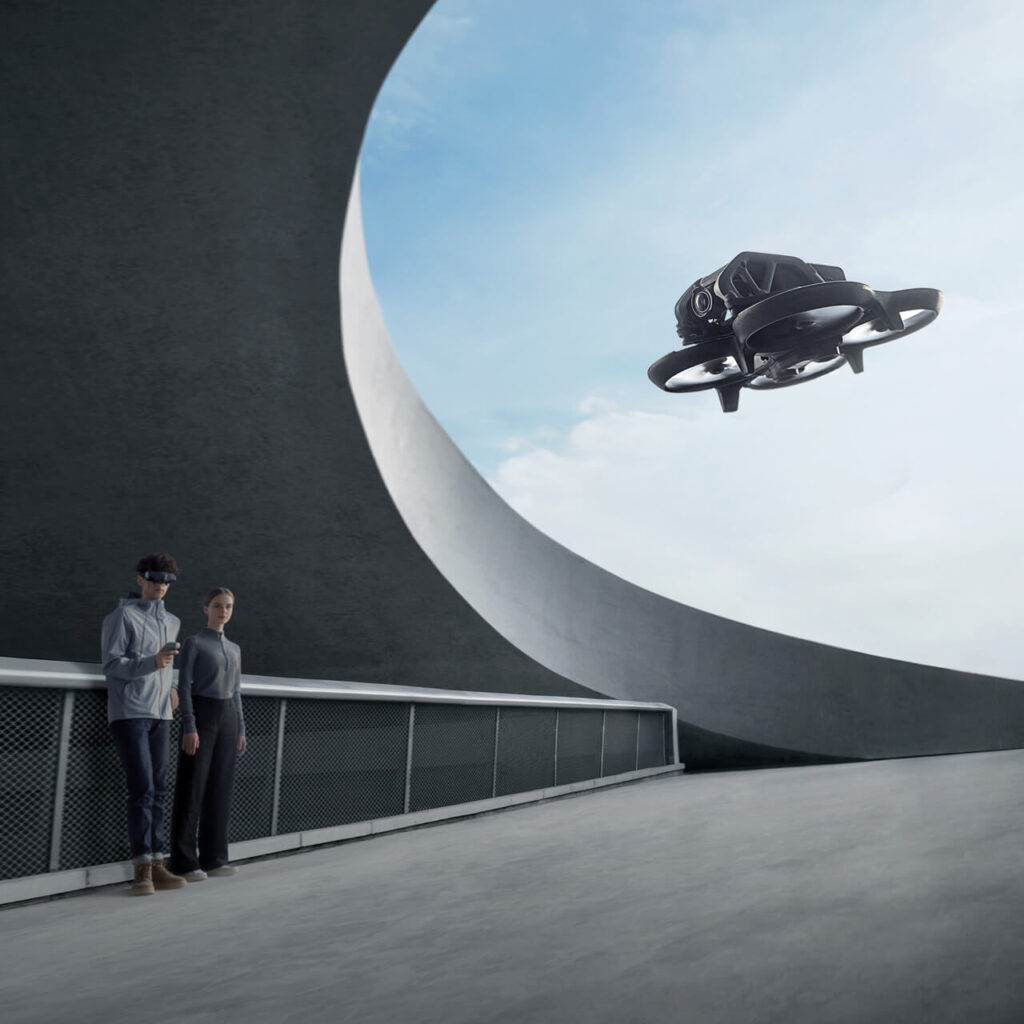Drones have opened up entirely new ways to explore the world, but most of them share one major limitation water. Whether it’s rain, mist, splashes, or full-on immersion, regular drones simply aren’t built for wet conditions. One unexpected dip, and you’re looking at serious damage or total loss.
That’s where waterproof drones come in.
These rugged machines are built to handle challenging environments from coastal cliffs and choppy lakes to rain-soaked forests. Whether you’re an outdoor content creator, a fishing enthusiast, or a professional working in search-and-rescue or infrastructure inspection, a waterproof drone can be a game-changer.
In this guide, we’ll walk you through:
- What waterproof drones are and how they work
- Key features and materials that set them apart
- The best waterproof drone models in 2025
- How to choose the right one for your needs
- And answers to common questions before you buy
Let’s get started.
What Is a Waterproof Drone?
A waterproof drone is engineered to operate safely in environments where moisture, rain, splash, or even submersion are possible. Unlike regular drones that might malfunction with just a little exposure to water, waterproof drones are built to survive and thrive where others fail.
Waterproof vs Water-Resistant: Know the Difference
Not all drones that can handle water are built the same. Here’s how they break down:
- Water-resistant drones can tolerate light rain or splashes but aren’t designed for full water contact.
- Fully waterproof drones can fly in the rain, land on water, float, and in some cases, even dive below the surface for short durations.
This classification is usually defined by an IP rating short for Ingress Protection. A rating like IP67 means the drone is completely dustproof and can handle immersion in water up to 1 meter for 30 minutes.
Why Waterproofing Matters More Than Ever
As drone use expands into flood-affected zones, remote filming, marine environments, and even emergency response, waterproofing becomes more than a luxury it’s a must.
Whether you’re planning to vlog your solo travel adventure, shoot near waterfalls, or support search-and-rescue teams during floods or landslides, waterproof drones help you fly without fear.
You also avoid the stress of weather-related delays a common headache for drone pilots who aren’t sure whether their drone can fly in the rain or if it might crash during sudden showers.
Real-World Scenarios Where They Shine
Waterproof drones are commonly used in:
- Outdoor filmmaking in wet, unpredictable environments
- Fishing and marine activities, especially with drones that carry bait or scan underwater
- Search-and-rescue operations where terrain is unsafe or flooded
- Surveying coastal or offshore infrastructure
- Capturing epic content from a travel vlogging drone
In these cases, regular drones might fail, while a waterproof model gives you peace of mind and uninterrupted performance.
A Note for New Buyers
If you’ve just started researching drones and feel overwhelmed with all the specs — like whether you need a Fly More Combo, or what a remote controller (RC) does — don’t worry. We’ll break it all down step by step in the upcoming sections.
And yes, if you’re concerned about things like drone weight categories or flying rules in India, we’ll cover that too because being waterproof is only one part of choosing the right drone in 2025.
What Makes a Drone Waterproof?
Waterproof drones aren’t just regular drones with a protective case. Their resistance to water is built right into the core design from the sealing of internal electronics to the materials used for the body and motors. If you’re considering buying a waterproof drone in 2025, it’s important to understand what gives it that water-resistant edge.
1. IP Rating (Ingress Protection)
The IP rating is the most reliable indicator of how water- and dust-resistant a drone truly is. For waterproof drones, you should look for a rating of IP67 or higher.
- IP67: Dustproof + can handle submersion in 1m of water for 30 minutes
- IPX8: Can operate while submerged in water beyond 1 meter (depends on manufacturer specs)
Understanding this rating is just as important as knowing about your drone’s camera resolution, flight time, or RC controller range because a high rating can make the difference between a clean landing and a soaked failure.
2. Sealed Electronics and Waterproof Housing
Waterproof drones use tight gaskets, rubber seals, and enclosed components to prevent water from reaching sensitive parts like the:
- Battery compartment
- Flight controller
- Gimbal and camera
- Motors and ESCs
This is especially crucial for buyers worried about first-time crashes near water, where even a splash could destroy a non-waterproof drone.
3. Corrosion-Resistant Materials
Flying near saltwater, fishing spots, or humid environments demands materials that won’t rust or degrade. That’s why most waterproof drones use:
- Treated aluminum or stainless-steel parts
- Marine-grade plastics
- Composite waterproof coatings
This level of build quality is essential whether you’re filming for a YouTube drone travel vlog, doing inspections near docks, or just flying in unpredictable monsoon weather.
4. Coated Internal Components
Many waterproof drones feature conformal coating a transparent, moisture-resistant chemical layer applied to circuit boards and electronic connections. This coating:
- Protects against condensation and splash damage
- Improves lifespan in humid environments
- Prevents short circuits after water exposure
This is similar to what’s done in some refurbished drones, where sellers apply aftermarket coatings to restore water resistance though it’s never as reliable as factory-sealed builds.
5. Buoyant Design and Drainage Systems
Some drones are made to float on water, or even recover from a flip a must for fishing drones or rescue scenarios. Features include:
- Buoyant landing gear or pontoons
- Internal drainage holes to release trapped water
- Self-righting systems that flip the drone upright
This level of smart design is becoming a new standard, especially in outdoor adventure filming and marine rescue applications.
These are the factors that determine whether a drone is just water-friendly or truly waterproof. As drone buyers become more serious in 2025, understanding these elements can be just as important as knowing which drone is best for content creators, or what regulations you must follow before flying.
Choosing the Perfect Waterproof Drone: Key Features to Look For
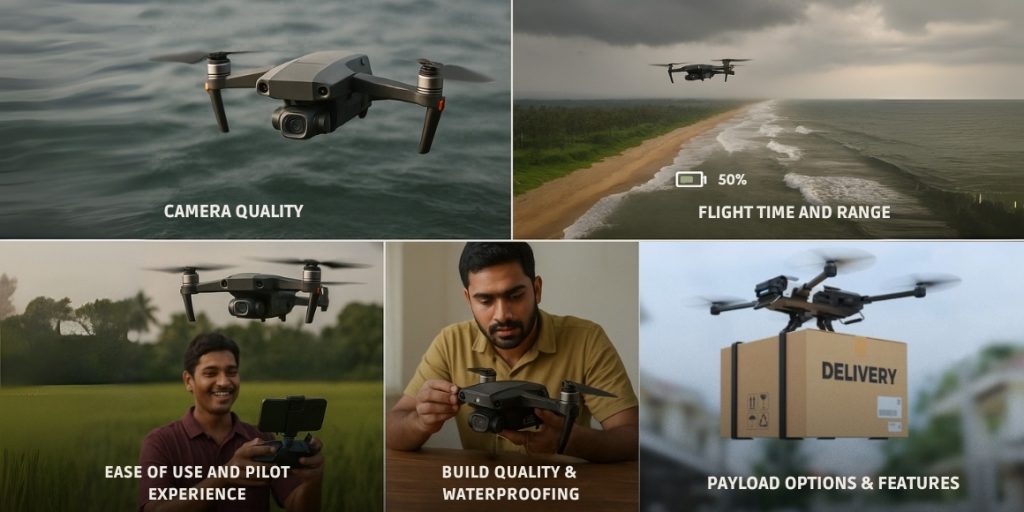
Buying a waterproof drone in 2025 isn’t just about finding one that can land on water it’s about finding a model that matches your goals, environment, and experience level.
Here’s what to evaluate before you make a decision.
1. Camera Quality
If you’re into filmmaking, travel vlogs, or YouTube content, camera performance will make or break your shots.
Look for:
- 4K or higher resolution (some offer 6K)
- A 3-axis gimbal for stabilized footage
- HDR support for vibrant color and detail
Many new buyers make the mistake of thinking a high-res camera is enough — but without proper gimbal stabilization, your footage can still turn out shaky or unusable.
Also, make sure the camera is housed in a water-sealed gimbal. This matters even more if you’re filming in rain, mist, or splashing water especially when planning to shoot across diverse terrains like mountains or coastlines.
2. Flight Time and Range
A typical waterproof drone offers around 25–30 minutes of flight time. Anything less could limit your ability to capture the full scene or complete a survey mission.
Also consider range especially if you’re:
- Flying from a boat
- Capturing footage of cliffs or coastal structures
- Surveying a wide area for environmental or search work
The DJI Mini 4 Pro, for instance, is praised for its balance of range, battery life, and performance though it isn’t waterproof itself, comparing specs like flight time and signal strength can help you evaluate alternatives.
3. Build Quality and Waterproofing Rating
Always check for at least an IP67 rating, especially if you’re operating in:
- Saltwater zones
- Tropical climates
- Monsoon-prone areas
Also inspect:
- Buoyant frame design
- Sealed motors
- Corrosion-resistant coating
Many newer drones are pushing toward multi-weather readiness, but only a few can truly handle both rain and submersion.
4. Ease of Use and Pilot Experience
If you’re new to drones, prioritize intuitive controls, auto-stabilization, and smart return-to-home features.
While drones like the DJI Fly More Combo offer these smart functions in a dry setting, some waterproof models are also beginning to include:
- Obstacle avoidance
- Beginner flight modes
- App-based navigation with waypoints
These features help reduce stress when flying over water, especially for first-time drone users.
5. Payload Options and Extra Features
Depending on your use case, you may want a drone that can:
- Carry fishing bait
- Attach loudspeakers for search missions
- Mount thermal or low-light cameras
These features aren’t just gimmicks they’re essential in agriculture, construction site monitoring, and rescue operations, where real-time decisions matter.
If you’re a content creator considering a waterproof drone as your first step into serious videography, look for modular options with swappable accessories. This future-proofs your investment without requiring a full upgrade down the line.
Top Waterproof Drones in 2025
Unlike standard drones from DJI or Autel that are not waterproof, these specialized drones are engineered for rugged environments rain, sea, and even underwater use.
Here are the top models to consider in 2025:
1. SwellPro SplashDrone 4
Best for: Aerial photography, rescue missions, and general outdoor use
The SplashDrone 4 is SwellPro’s flagship waterproof quadcopter. With IP67 waterproofing, it can take off from water, land in the rain, and even float. Built for serious creators and professionals, it also supports various payloads including cameras, release modules, and sensors.
Key Specs:
- Camera: 4K with 3-axis gimbal (optional payload)
- Max Flight Time: 30 mins
- Range: 5 km
- Waterproof Rating: IP67
- Special Features: Waterproof body, multiple payload options, rescue capability
Why it stands out: The SplashDrone 4 combines powerful aerial features with full waterproofing, making it suitable for disaster zones, marine operations, and aerial creators.
2. SwellPro Fisherman FD1
Best for: Fishing and marine exploration
Purpose-built for anglers, the FD1 is a robust waterproof drone with a dedicated bait release system. It’s designed to carry heavy payloads, even in strong winds and coastal conditions.
Key Specs:
- Camera: Optional 4K add-on
- Max Flight Time: 28 mins
- Payload Capacity: 2 kg
- Waterproof Rating: IP67
- Special Features: Bait release, floating body, strong wind resistance
Why it stands out: If you’re serious about drone fishing, this is one of the best tools available in 2025.
3. PowerVision PowerEgg X Wizard
Best for: Versatile use across land, air, and wet conditions
The PowerEgg X Wizard is a weatherproof, modular drone that also functions as a handheld camera. While it’s not fully submersible, the Wizard kit makes it rainproof and water-landing capable.
Key Specs:
- Camera: 4K UHD with 3-axis gimbal
- Max Flight Time: 30 mins
- Waterproofing: All-weather kit with floats
- Special Features: Handheld mode, voice sync, waterproof shell
Why it stands out: It’s a flexible choice for creators who want one device for both vlogging and aerial shots, including during rainy or humid travel shoots.
4. QYSEA FIFISH V6 Expert
Best for: Underwater inspection and marine content creators
This isn’t your typical drone the FIFISH V6 Expert is a true underwater ROV (remotely operated vehicle). Designed for submersion up to 100 meters, it’s perfect for underwater filmmaking, search missions, or inspecting offshore infrastructure.
Key Specs:
- Depth Rating: 100 meters
- Camera: 4K UHD with 166° wide-angle lens
- Tethered operation with VR head tracking
- Battery: Up to 5 hours
- Waterproof Rating: IPX8
Why it stands out: It’s the go-to option for deep-sea inspections, professional underwater shoots, or even coral reef research.
Which Waterproof Drone Is Right for You?
Choosing the right waterproof drone depends on what you plan to do with it whether it’s aerial filming over water, fishing, inspection work, or underwater exploration. Below is a side-by-side comparison of the top models we just discussed:
Comparison Table: Best Waterproof Drones in 2025
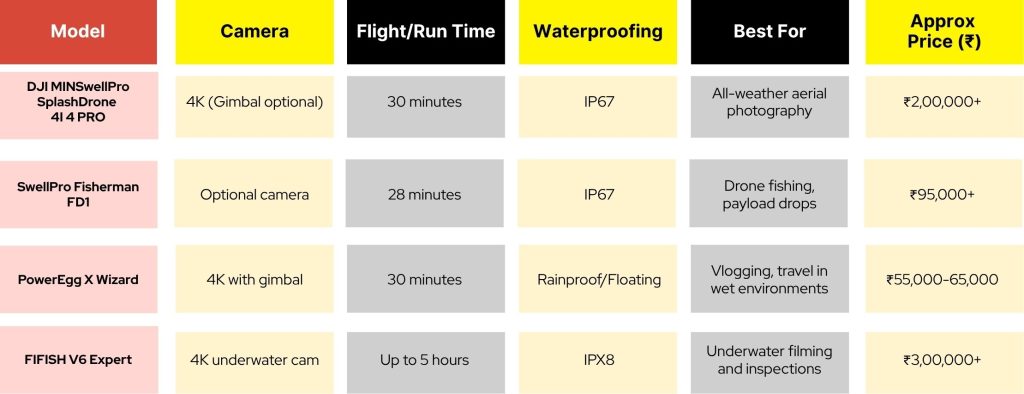
How to Choose Based on Use Case
Here’s a quick breakdown of what to pick based on your needs:
For Adventure Content Creators
You’ll want a model that flies in rain, has excellent camera stability, and can land on water if needed. The SplashDrone 4 or PowerEgg X Wizard is ideal here both are rugged enough for the elements and versatile enough for stunning footage.
If your focus is aerial travel content, this drone type complements what’s covered in guides on content creation journey with drones where the ability to film in any weather adds serious value.
For Anglers or Drone Fishing
Choose the Fisherman FD1. It’s purpose-built for dropping bait and withstanding saltwater spray making it far more effective than modifying a traditional drone for marine use.
For Underwater Inspection or Research
Go with the FIFISH V6 Expert. It’s not a flyer, but a full underwater ROV perfect for marine biologists, divers, or infrastructure inspection teams.
For Travel Vloggers and Hobby Pilots
The PowerEgg X Wizard gives you rain-flying ability plus a handheld camera option a big plus for solo travelers and creators looking for lightweight, multi-use equipment.
How to Choose the Best Waterproof Drone for Your Needs
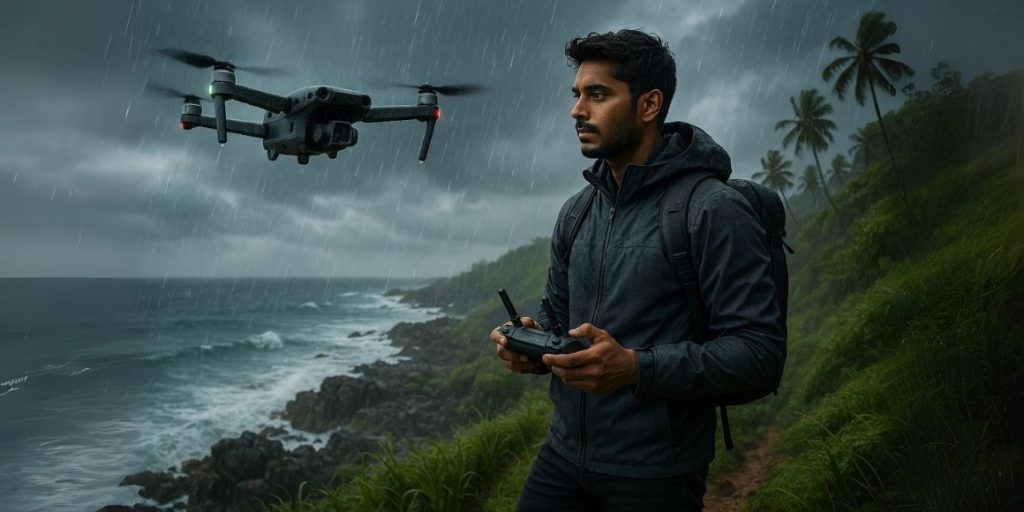
Not all waterproof drones are built for the same purpose. Before spending on a high-end model, ask yourself a few key questions:
1. What’s your primary use case?
- Filmmaking or travel vlogging? Look for drones with a gimbal-stabilized 4K camera and smooth flight performance.
- Fishing or bait dropping? Choose a drone like the Fisherman FD1 with payload release systems and strong saltwater resistance.
- Underwater inspections or marine research? Opt for a tethered ROV like the FIFISH V6 Expert.
- Emergency work or weather-dependent flights? A drone like the SplashDrone 4 that can handle rain and land on water is essential.
If your use case involves long hours and critical accuracy such as construction site surveillance or flood response durability and signal range should be your priority.
2. What’s your flying environment?
- Flying from boats or coastal areas? Focus on buoyant design and wind resistance.
- Inland rivers, misty terrains, or rainy climates? Look for drones with excellent water sealing and rain-flight capabilities.
- Urban or protected airspace? Don’t forget to consider drone weight and licensing rules (check how drone weight affects regulations).
3. What’s your experience level?
- First-time flyer? Look for smart flight modes, auto-return, and obstacle avoidance.
- Experienced pilot? You might prefer full manual controls, programmable routes, or payload customizations.
There’s no one-size-fits-all. The best waterproof drone is the one that handles your unique needs not necessarily the most expensive or feature-heavy.
And don’t forget: whether you’re flying near forests, oceans, or farms, always check your local regulations. Flying freely might still require a license in India, especially for commercial or outdoor filming projects.
Frequently Asked Questions
1. Can waterproof drones fly in heavy rain or storms?
Most waterproof drones, like the SwellPro SplashDrone 4, can operate safely in light to moderate rain and gusty wind. However, flying in storms or severe weather is still risky due to reduced visibility and GPS disruption. Always check wind speed and local forecasts before flying.
2. Are underwater drones the same as waterproof drones?
No. Waterproof drones are usually aerial drones that can land on or float on water, while underwater drones (ROVs) like the FIFISH V6 Expert are designed to dive and operate completely underwater using a tethered connection.
3. Do waterproof drones require special maintenance?
Yes. Even though they’re designed for water exposure, regular rinsing (especially after saltwater use), drying, and battery inspection are essential. It’s similar to caring for refurbished drones — performance depends on upkeep.
4. Are waterproof drones allowed in restricted zones like coastal borders or national parks?
Drone laws in India vary by location. Waterproof drones aren’t treated differently under DGCA regulations, so always check if you need commercial drone licenses or special permissions to fly near protected or sensitive zones.
5. Can waterproof drones capture high-quality cinematic content?
Yes. Many of them are equipped with 4K stabilized cameras and gimbals. Models like the SplashDrone 4 or PowerEgg X Wizard can deliver professional-level footage — especially useful for YouTubers or travel vloggers capturing dynamic weather or water-based adventures.


